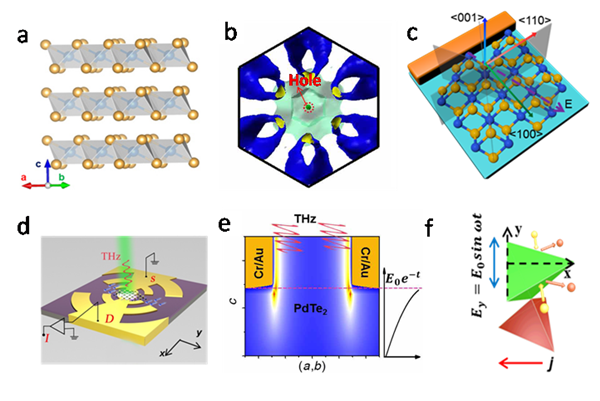- 首页 >> Research >> Research Progress
Research Progress
Photodetector linked to topological semimetal brings blossoming future for high-frequency optoelectronics
Long-wavelength detection at high-frequency microwave or terahertz (1THz~1012Hz) band is highly demand nowadays for myriad applications in fields such as security imaging, bioassay, and telecommunication (next 6G interconnection). However, there exists so-called terahertz gap (0.1THz~10THz, photon energy hu~0.4~40meV) due to lack of efficient manipulation of photodiode (PD) or electrical diode (ED) techniques at this particular spectrum region. PDs for low photon-energy is difficult to operation at room-temperature due to thelack of light-induced effect, and the frequency of EDs is inhibited by the carrier transit-time can hardly reach to THz frequency. Thus, considerable efforts have been invested from material and optoelectronic communities to search for material platform with peculiar properties that can circumvent these technical bottlenecks.
The emergence of type-II Dirac Semimetal, a van der Waals layered materials hosting tilted Dirac cone, is reported recently to possess congenital advantages for broadband photon absorption and exotic behavior of carrier transport. Traditionally, semimetal-based materials have not been considered for PDs owing to its drawbacks imposed by large dark current and high noisy when a bias transverse across the material, and device implementation is elusive for semimetal-based materials. As recently published in Science Advances, researchers from the Shanghai Institute of Technical Physics (SITP) of the Chinese Academy of Sciences, in collaboration with the University of L’Aquila and Nanjing University, has successfully realized type-II Dirac semimetal-basedPDs with room-temperature capabilities of fast response, broadband as well as high signal-to-noise ratio operational in the high-frequency microwave and terahertz band.
In a study published online in Science Advances, Prof. WANG Lin, Profs. CHEN Xiaoshuang and LU Wei from Shanghai Institute of Technical Physics of the Chinese Academy of Sciences (SITP), cooperating with Prof. Antonio Politano’s group from University of L'Aquila in Italy and Prof. Wan Xiangang’s group from Nanjing University developed a new kind of photodetector linked to topological.
During this study, a PdTe2 single-crystal grown via chemical vapor transport route is reported featuring electronic structure of type-II Dirac semimetal, with tilted Dirac cone forming a large Fermi sea, where the carriers can be driven back and forth by alternating electric field. The tilted Dirac cone cutting at the Fermi level forms a semi-closing electron-hole pocket so that most of the incident photon can be absorbed.
One can imagine that "a Dirac cone has a shape like a funnel, and it has a large projection area when it is tilted, which means the density of states is larger for a tilted Dirac cone". The type-II Dirac semimetal is protected by its C3V inversion symmetry with atomic-thin thickness, offering greater versatility or flexible than traditional materials for smart system.
There are several critical issues for terahertz detection within Dirac semimetal: the terahertz wave is always several hundred micrometers (mm) long, and the semimetal materials is only tens of nanometer (nm) thickness, which means that the terahertz wave should be compressed by more than three orders of magnitude in order for efficient coupling or absorbed by materials. Researchers have designed a metallic antenna log-periodic structure which contact symmetrically to PdTe2, and the antenna is electrically connected to readout electronics for signal recording.
With this particular design, the THz field can be successfully localized at metal-material interface, driving the carriers near the interface. The team's study validates that synergistic effect of the C3v inversion-symmetry breaking caused by metal-material charge transferring, AC driven oscillation of surface carriers by localized field, allowing the direct detection of THz signal without applying bias voltage or introducing additional noise.
Detection sensitivity of 2pW/Hz0.5 and fast response can be derived, rival with commercially available detectors, which verified that the bizarre behavior of semimetal materials may bring us transformative ways toward electromagnetic-power detection without introducing any stringent doping or grown, cooling systems for traditional materials, and thus solving the technical bottlenecks of long-wavelength photon detection.
“Our findings open new opportunities for exploring performing systems in the highly pursuit terahertz band with capabilities of real-time, low-power consumption, by taking advantages of novel transport in topological protected electronic states and their versatile symmetry-breaking operation. Also, it make possible to study the exotic behavior of carriers in topological materials for future information technology" Said by Prof. WANG Lin from SITP.

Contact
WANG Lin Shanghai Institute of Technical Physics E-mail: wanglin@mail.sitp.ac.cn
